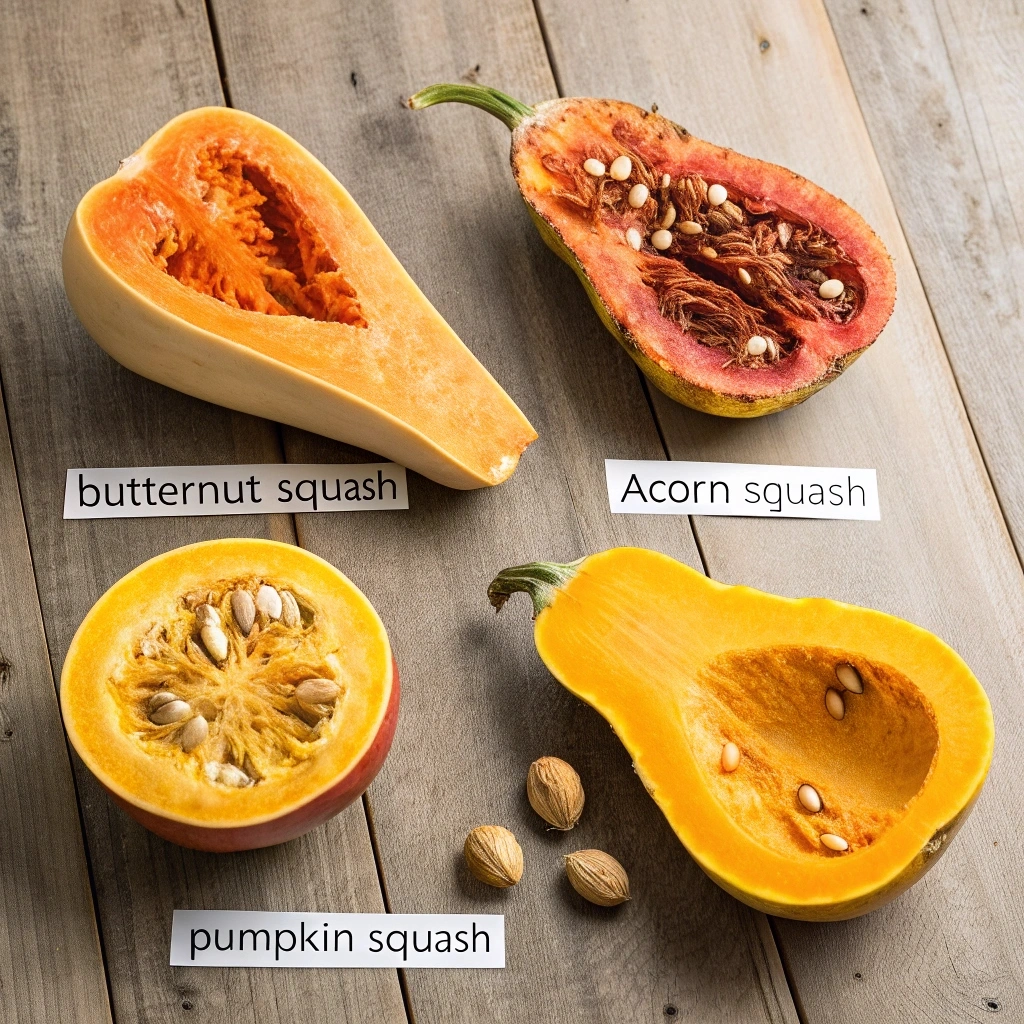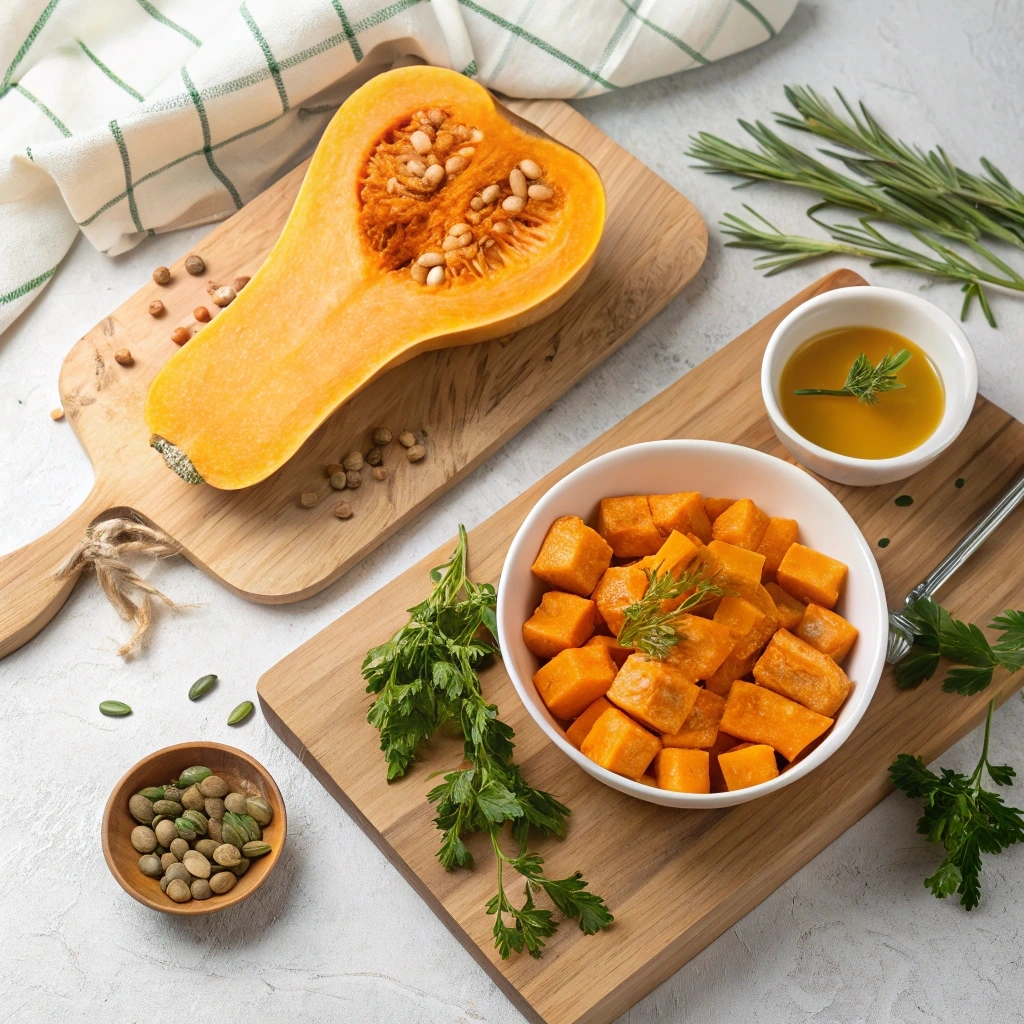Butternut squash is a favorite vegetable in many households, prized for its versatility, nutritional value, and distinctive flavor. If you’ve ever asked yourself, “What does butternut squash taste like?” The secret lies in its naturally sweet, nutty flavor and creamy texture, making it a standout ingredient in both savory and sweet recipes. Whether roasted, pureed, or included in soups, this squash adapts beautifully to a wide range of recipes, earning its place in cuisines worldwide.
In this article, we’ll explore the taste of butternut squash in depth, discuss how different cooking methods influence its flavor, and examine its role in global cuisines. We’ll also provide tips for preparation and highlight its nutritional benefits. By the end, you’ll have a comprehensive understanding of why butternut squash is a staple in kitchens around the world.
For more ideas, take a look at our guide to quick and easy Dinner recipes
What Does Butternut Squash Taste Like?
Flavor Profile of Butternut Squash
The taste of butternut squash is often described as naturally sweet with a subtle nutty undertone. Its flavor is milder than sweet potatoes but sweeter and creamier than pumpkins. When cooked, the texture becomes velvety, making it an excellent choice for soups, purees, and desserts.
- Sweetness: Butternut squash has a gentle sweetness that complements both savory and sweet recipes.
- Nutty Undertones: A mild nutty flavor adds depth, making it unique among winter squash varieties.
- Creamy Texture: When roasted or pureed, its smooth texture enhances dishes ranging from soups to pies.
How Cooking Methods Influence Taste
Cooking butternut squash enhances its natural flavor while adding new dimensions depending on the method. Each technique brings out unique characteristics that make it suitable for various dishes.
Roasting
- Roasting enhances the squash’s natural sweetness, creating a rich flavor with caramelized, crispy edges.
- Best spices to pair with roasted butternut squash include cinnamon, nutmeg, and paprika.
Steaming
- Steaming retains the squash’s natural sweetness and delicate flavor while preserving its nutrients.
- This method works well for pureeing into soups or baby food.
Boiling
- Boiling softens the squash but can dilute its flavor slightly, making it ideal for recipes where it’s blended with other ingredients, such as stews.
Sautéing
- Sautéing with garlic, thyme, or sage adds savory notes to the squash, creating a well-balanced dish.
For detailed cooking tips, Healthline provides step-by-step preparation advice.
Comparing Butternut Squash to Similar Vegetables
To better understand its flavor, it’s helpful to compare butternut squash to other vegetables commonly used in similar recipes.
Sweet Potatoes vs. Butternut Squash
- Taste: Both are sweet, but sweet potatoes have a more robust flavor, while butternut squash is milder and nuttier.
- Texture: Sweet potatoes are denser, whereas butternut squash becomes creamier when cooked.
Pumpkin vs. Butternut Squash
- Taste: Pumpkin is less sweet and has a slightly earthy flavor compared to the rich, sweet profile of butternut squash.
- Texture: Butternut squash is smoother and less fibrous, making it easier to work with in purees and soups.
Acorn Squash vs. Butternut Squash
- Taste: Acorn squash has a nuttier and less sweet flavor compared to butternut squash, giving it a more savory profile.
- Usage: While acorn squash is often roasted or stuffed, butternut squash is more versatile, suitable for both sweet and savory dishes.

Culinary Uses of Butternut Squash
The versatility of butternut squash allows it to shine in various recipes across different cuisines. From soups to desserts, this squash adapts seamlessly to a wide array of dishes.
Savory Applications
- Soups: Creamy butternut squash soup, often paired with ginger or nutmeg, is a fall favorite.
- Casseroles: Adds a rich, velvety texture to baked dishes.
- Roasted Sides: Combined with root vegetables for a hearty side dish.
Sweet Applications
- Pies and Desserts: Its natural sweetness makes it ideal for pies, muffins, and custards.
- Smoothies: Pureed squash adds creaminess and a hint of sweetness to healthful smoothies.
International Recipes Featuring Butternut Squash
In the United States
Butternut squash holds a special place in American kitchens, especially during the colder months. For instance, it is often transformed into creamy soups that are both comforting and satisfying. In addition, casseroles featuring butternut squash offer a rich, velvety texture that pairs beautifully with other seasonal ingredients. Roasted butternut squash is another favorite, frequently seasoned with brown sugar or fresh herbs like rosemary to enhance its natural sweetness. This simple preparation method highlights its caramelized flavor, making it a popular choice for holiday meals.
In Europe
European cuisines showcase butternut squash in a variety of creative ways. For example, in Italy, it is often used in risottos where its creamy texture melds perfectly with the rice, creating a hearty and flavorful dish. Additionally, Italians use it as a filling for ravioli, pairing it with sage butter to achieve a classic and well-loved combination. In France, butternut squash is commonly pureed into silky soups or baked into savory tarts, showcasing its versatility and mild sweetness in elegant dishes.
In Asia
Asian dishes incorporate butternut squash into recipes that emphasize bold and complex flavors. For example, Indian cuisine frequently combines it with lentils and aromatic spices to create hearty curries that are both filling and flavorful. Meanwhile, in Thai cooking, butternut squash takes on a whole new profile when simmered in coconut milk-based soups. Ingredients like lemongrass, chilies, and ginger complement its natural sweetness, creating a balanced and delicious meal.
In South America
South American recipes highlight butternut squash in both savory and sweet applications. For instance, in Argentina, it is added to stews where it blends seamlessly with beans, meats, and spices to create hearty, comforting dishes. Moreover, in Brazil, its natural sweetness makes it a perfect addition to desserts such as puddings and cakes, where it adds a creamy texture and vibrant color.
This global perspective on butternut squash demonstrates its ability to enhance a wide variety of dishes, making it a true culinary favorite.
Nutritional Benefits of Butternut Squash
Key Nutrients
- Vitamin A: Supports vision and immune health.
- Vitamin C: Strengthens the immune system and supports healthy skin.
- Potassium: Regulates blood pressure and muscle function.
- Fiber: Improves digestion and aids in weight management.
Health Benefits
- Improves Eye Health: Vitamin A content helps prevent vision-related issues.
- Boosts Immunity: Its high Vitamin C content helps fortify the immune system.
- Promotes Digestive Health: Fiber content supports gut health and reduces constipation.
- Aids Weight Management: Low-calorie yet filling, making it a great choice for healthy eating.

FAQs About Butternut Squash Taste and Nutrition
What does butternut squash taste similar to?
Butternut squash offers a taste that resembles a blend of sweet potatoes and pumpkins, with a mild sweetness and earthy undertones.. It shares the natural sweetness of sweet potatoes but with a milder, nuttier undertone. Compared to pumpkins, butternut squash is sweeter and has a creamier texture. For example, when roasted, it develops a caramelized sweetness that resembles sweet potatoes, while its mild nutty flavor aligns with the earthiness of certain squash varieties. Its versatile taste makes it a suitable substitute for sweet potatoes or pumpkins in various recipes, such as soups, pies, and casseroles.
How would you describe the taste of butternut squash?
The taste of butternut squash can be described as mildly sweet with a hint of nuttiness. Its flavor is neither overwhelming nor bland, which allows it to complement a wide range of ingredients. When cooked, it becomes rich and creamy, making it ideal for dishes like purees, soups, and desserts. For instance, roasting enhances its sweetness and adds a subtle caramelized note, while steaming preserves its delicate, fresh flavor. Its balanced taste is versatile enough to be paired with savory spices like thyme and paprika or sweet elements like cinnamon and brown sugar.
Does butternut squash taste like potatoes?
While butternut squash shares a similar starchy texture with potatoes when cooked, their flavors are quite different. Potatoes have a neutral, earthy flavor, while butternut squash is naturally sweet with nutty undertones. For example, roasted butternut squash develops a caramelized sweetness that potatoes lack. However, their textural similarities make butternut squash a great alternative in mashed or roasted dishes, especially for those seeking a sweeter, more flavorful option.
Is sweet potato or butternut squash healthier?
Both sweet potatoes and butternut squash are highly nutritious and offer unique health benefits, but the choice depends on your dietary needs.
- Butternut Squash: Lower in calories and carbohydrates, making it an excellent option for weight management or low-carb diets. It is also rich in Vitamin A, Vitamin C, and potassium, which support immunity, vision, and heart health.
- Sweet Potatoes: Higher in calories and slightly more fiber, providing a more filling option. They also contain more Vitamin B6 and manganese, which support metabolism and bone health.
In summary, butternut squash is a lighter choice with fewer calories and carbs, while sweet potatoes provide more energy and fiber. Both are nutrient-dense and excellent additions to a balanced diet, so the healthier choice depends on your nutritional goals.
Conclusion
Butternut squash, with its naturally sweet, nutty flavor and creamy texture, stands out as one of the most versatile and beloved ingredients in global cuisine. Its ability to adapt seamlessly to both savory and sweet dishes has made it a staple in kitchens worldwide. For example, roasting butternut squash enhances its sweetness and brings out a caramelized depth, making it a perfect addition to salads, grain bowls, or holiday sides. Similarly, pureeing it into soups creates a rich and comforting dish that warms the soul during colder months.
In addition, butternut squash’s adaptability extends to desserts, where its natural sweetness serves as a healthier alternative to processed sugars. From pies and puddings to muffins and cakes, it adds a creamy texture and a vibrant hue that enhances any dish. Moreover, its impressive nutritional benefits, including high levels of Vitamin A, Vitamin C, fiber, and potassium, make it not only delicious but also a smart choice for maintaining a balanced diet.
Furthermore, its long shelf life and minimal growing requirements contribute to its appeal as an eco-friendly and sustainable ingredient. Whether you’re preparing a quick weekday meal or a special holiday dish, butternut squash offers a unique combination of flavor, nutrition, and versatility.
Next time you plan your meals, think about incorporating butternut squash into your recipes. Its ability to elevate both the taste and nutritional value of any dish ensures that it will remain a cherished ingredient for years to come. By embracing this vegetable, you’re not only enriching your meals but also connecting with a tradition that spans cultures and generations.

